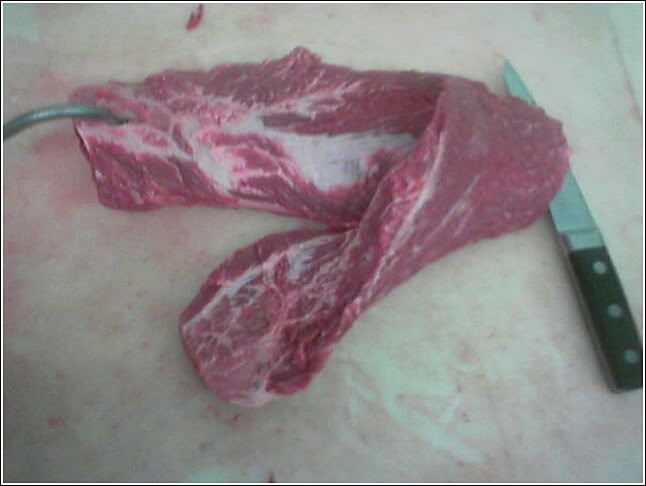You may choose a boneless rib roast or have one with the bones left on (it is usually a little less expensive per pound because you are paying for the bones).
If you get a roast with bones, there will be two different types of bones. There will be the rib bones (selecting a roast, you usually refer to the size you want as either a 2 bone or 3 bone or more-up to even a 7 bone roast) and the chine bones, which is a part of the back bone attached to the rib. Ask your butcher to remove the chine bones for you.
If you like, you can trim off the rib bones. You still want to cook the meat sitting on the ribs because the meat cooks more consistently lifted out of any liquid that may escape, but you can also add something extra to the bottom of the roast as it cooks by inserting some seasonings between the bones and the meat. Spread some sliced garlic, a little olive oil, salt and pepper over the bones and then tie the roast back on top of the flavoured bones with a single tie using cotton butcher's twine to keep it in place. This makes the bones more succulent and also adds a great flavour to the roast itself. By having the bones separated, it makes carving the roast much easier too.
Your oven has been preheated to 400 degrees and you have your roast trimmed, seasoned and tied on a parchment lined baking tray. With this method, your roast will not give up a lot of liquid, so there is no need to set it on a rack above the tray. After the first 1/2 hour, referred to as the "30 minute sizzle", where the sear happens, lower the temperature to 300 degrees for the remaining 30-45 minutes. (Remember, this is a 2 bone roast weighing approximately 4 1/2 pounds.) When you take it out of the oven, you must let it rest a further 20-30 minutes. This allows the meat to finish cooking and for the juices to run back into the meat rather than onto your cutting board. You can cover it with a tin foil tent to help keep it warm.
Remove the string and place the ribs on your serving tray (or save them for cook and cook's helper). To make the whole carving situation easier, cut the roast in half crosswise from where the top is, straight down to where the bones were, perpendicular to the way you will slice it. This makes a flat surface on which to slice the roast. You should be able to get 4 generous slices per half, so this roast yields 8 slices.
 |
| Rare, tender roast beef ready for serving. |







 Ok. That's enough information about the cut of meat we recommend.
Ok. That's enough information about the cut of meat we recommend.


